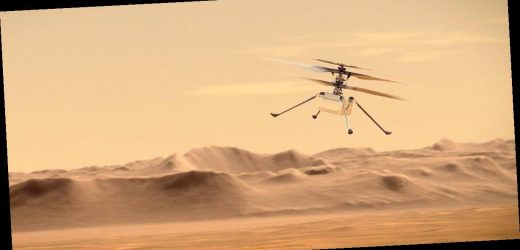- NASA’s Perseverance Mars rover is about to drop a helicopter from its belly and film its flights.
- Ingenuity is the first space rotocraft, and it could pioneer a new way to explore other planets.
- NASA announced that the helicopter will start flying as early as the first week of April.
- See more stories on Insider’s business page.
NASA’s Perseverance Mars rover is about to drop a four-pound helicopter from its belly, then record footage of it flying over Martian plains.
The $85 million rotocraft, called Ingenuity, could pioneer a new approach to exploring other planets. Though for now just a technological demonstration, the drone is set to conduct up to five test flights this spring. Two cameras on its underside should record to Martian surface from above as it flies.
NASA announced on Wednesday that its helicopter team has picked a location for these flights. The first takeoff could happen as soon as the first week of April. The agency plans to share more details in a press conference on Tuesday.
If it succeeds, Ingenuity could beam back some incredible video. Perseverance is expected to follow the flights with its own cameras as well.
Success would bode well for future missions that seek to explore the watery moons of Jupiter and Saturn using helicopter technology.
However, since nobody has ever flown a helicopter on Mars, unknown factors could thwart Ingenuity’s attempts. In January, another pioneering Mars technology — a “mole” on NASA’s InSight lander that was programmed to hammer deep into the planet’s crust — was unable to complete its mission due to unexpectedly thick soil.
“The helicopter Ingenuity is a high-risk, high-reward endeavor,” Matt Wallace, the Perseverance deputy project manager at NASA’s Jet Propulsion Laboratory, said in a briefing ahead of the rover’s landing. “There’s always going to be some probability of an issue. But that’s why we’re doing it. We’ll learn from the issue if it occurs.”
Spinning through the thin Martian atmosphere
After it landed in an ancient Martian lake bed in February, Perseverance began checking out its systems and testing its tools. Now the rover is entering a new phase of its mission: It’s helicopter time.
Because communicating with spacecraft on Mars takes a few minutes, ground controllers on Earth can’t direct Ingenuity’s flight in real time. So engineers have designed and programmed the helicopter to carry out up to five flights autonomously, within a span of 30 Martian days (roughly one Earth month).
To catch enough air in the thin Martian atmosphere, the helicopter’s four carbon-fiber blades have to spin in opposite directions at about 2,400 revolutions per minute — about eight times as fast as a passenger helicopter on Earth. Solar panels on top of the spacecraft should power that spinning.
Ingenuity’s first flight will just test that the helicopter can get a few feet off the ground, hover for about 30 seconds, and touch back down. From there, each test will be more difficult than the last, culminating in a final flight that could carry the helicopter over 980 feet (300 meters) of Martian ground.
Even one short flight would be a major achievement.
“It will be truly a Wright Brothers moment, but on another planet,” MiMi Aung, project manager for the helicopter team, said in a pre-landing briefing. “Every step going forward will be first of a kind.”
After Ingenuity finishes its flights, Perseverance will begin its main mission: driving across a former river delta and searching for signs of ancient alien microbes.
Source: Read Full Article


